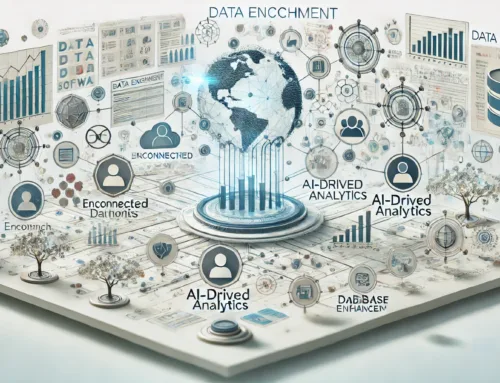Enhancing your data quality through strategic enrichment practices can lead to a deeper understanding of your business landscape. By implementing top-tier data enrichment techniques, you can unlock a treasure trove of insights that fuel informed decision-making and drive business success. From standardization to integration and beyond, these techniques hold the key to transforming raw data into actionable intelligence that propels your organization forward. Discover how these methods can revolutionize your data strategy and propel your business towards unparalleled growth and competitiveness.
Data Cleansing
When it comes to obtaining valuable insights from your data, one crucial step that cannot be overlooked is data cleansing. Data cleansing is an essential aspect of data quality assurance that involves identifying and correcting errors or inconsistencies in your dataset. By ensuring that your data is accurate, consistent, and up-to-date, you lay a solid foundation for effective data enrichment techniques to be applied.
Data cleansing is a fundamental process that helps in improving the overall quality of your data, making it more reliable and valuable for analysis. Through the use of data cleansing tools, you can streamline the process of identifying and rectifying errors such as duplicates, missing values, and formatting issues. This, in turn, enhances the effectiveness of data enrichment tools by providing them with clean and standardized data to work with.
Data Validation
When it comes to data validation, accuracy is key. Ensuring that your data is valid and reliable is crucial for making informed business decisions. Data validation plays a vital role in maintaining overall data quality.
Accuracy in Data
To ensure the accuracy of data, data validation plays a crucial role in the process of data enrichment. Data accuracy is fundamental for enhancing business insights and achieving data precision. When focusing on accuracy in data, consider the following key aspects:
- Validation Rules: Implementing validation rules ensures that the data entered meets specified criteria, preventing inaccuracies from entering the system.
- Data Cleansing: Regularly cleansing data by removing duplicates, correcting errors, and standardizing formats improves data accuracy and reliability.
- Cross-Field Validation: Checking the consistency of data across different fields helps maintain accuracy and coherence within the dataset.
- Automated Validation Processes: Utilizing automated tools for data validation streamlines the process, reduces errors, and enhances the overall accuracy of the enriched data.
Importance of Validation
Ensuring the accuracy of data is a critical aspect of data enrichment that directly impacts the quality of business insights derived from the data. Validation techniques play a key role in this process by verifying the correctness, completeness, and consistency of the data. By implementing validation techniques, such as cross-field validation, format validation, and range validation, businesses can identify and rectify errors or inconsistencies in their datasets, ensuring the reliability of the information used for decision-making.
Validating data is essential for enhancing the overall quality of data enrichment. It helps in eliminating inaccuracies and redundancies, leading to more reliable and trustworthy insights. Through the use of validation techniques, organizations can improve data integrity, enhance data quality, and ultimately derive more meaningful and actionable business insights. By investing time and resources in validating data, businesses can maximize the benefits of data enrichment and make informed decisions based on accurate and reliable information.
Ensuring Data Quality
Enhancing data quality through effective data validation is a fundamental step in the data enrichment process. Data validation ensures that the information in your datasets is accurate, consistent, and reliable for making informed business decisions. Here are four key practices to ensure data quality:
- Data Profiling: Utilize data profiling techniques to assess the quality, completeness, and consistency of your data. This helps in identifying anomalies and discrepancies that might impact the accuracy of your insights.
- Data Governance: Implement strong data governance policies to establish rules and standards for data validation. This framework ensures that data is managed consistently across the organization, promoting reliability and trust in the information being used.
- Data Enrichment Techniques: Combine data enrichment techniques with validation processes to enhance the quality of your datasets. Enriching data with additional information can help fill gaps and improve the overall completeness and accuracy of your data.
- Continuous Monitoring: Regularly monitor your data quality through automated checks and manual reviews. By continuously validating your data, you can quickly identify and rectify any issues that may arise, ensuring the ongoing accuracy and reliability of your insights.
Data Segmentation
When it comes to data segmentation, you can effectively analyze your target audience by dividing them into specific groups based on demographics, behavior, or preferences. This segmentation allows for a more tailored approach in understanding customer needs and creating personalized marketing strategies. By identifying behavioral patterns within these segmented groups, you can gain valuable insights into consumer trends and optimize your business decisions for better outcomes.
Targeted Audience Analysis
Often overlooked but crucial in maximizing the impact of data-driven decision-making is the practice of targeted audience analysis, specifically through data segmentation. By segmenting your data effectively, you can gain valuable insights into your audience’s preferences and behaviors, enabling you to tailor your strategies for better outcomes.
- Enhanced Audience Profiling: Data segmentation allows for a more detailed understanding of your target audience, helping you create personalized marketing campaigns.
- Improved Market Segmentation: By dividing your audience into distinct segments based on characteristics such as location or behavior, you can target specific markets more effectively.
- Refined Customer Profiling: Data segmentation helps in creating detailed profiles of different customer groups, leading to more personalized and targeted communication.
- Deeper Demographic Analysis: By analyzing demographic data within segmented groups, you can uncover trends and patterns that can guide product development and marketing strategies.
Through targeted audience analysis and data segmentation, businesses can refine their marketing efforts, improve customer engagement, and drive better business outcomes.
Behavioral Patterns Identification
To further optimize your data-driven decision-making process and refine your understanding of customer behavior, delving into behavioral patterns identification through data segmentation is paramount. Behavior analysis involves scrutinizing how customers interact with your products or services, while pattern recognition allows you to pinpoint recurring trends within this behavior. By segmenting your data based on these patterns, you can uncover valuable insights that may have been overlooked otherwise.
Identifying behavioral patterns enables you to tailor your marketing strategies more effectively, target specific customer groups with personalized messages, and enhance overall customer experience. This approach not only boosts customer satisfaction but also drives business growth by increasing conversion rates and customer loyalty.
Through data segmentation, you can categorize customers based on their preferences, buying habits, and interactions with your brand. This segmentation allows for the creation of targeted campaigns that resonate with each customer segment, leading to improved engagement and higher ROI. In essence, behavioral patterns identification is a powerful tool for gaining a deeper understanding of your customer base and making informed business decisions.
Data Integration
Regularly, businesses find themselves grappling with vast amounts of data from various sources. Data integration plays a crucial role in consolidating this disparate data to provide a unified view for analysis. Here are four key aspects to consider for effective data integration:
- Data Enrichment Strategies: Implementing data enrichment strategies enhances the quality and depth of the integrated data, providing more valuable insights for decision-making processes.
- Integration Challenges: Overcoming integration challenges such as data silos, incompatible formats, and varying data quality levels is essential to ensure a seamless integration process.
- Data Quality: Prioritizing data quality during integration is vital to guarantee the accuracy and reliability of the integrated information, leading to more informed business decisions.
- Integration Solutions: Utilizing advanced integration solutions like Extract, Transform, Load (ETL) tools or Application Programming Interfaces (APIs) can streamline the integration process and facilitate the harmonization of diverse data sources.
Data Normalization
In dealing with diverse data sources for effective business insights, the process of data normalization emerges as a pivotal step. Data normalization, a crucial aspect of data standardization and enrichment, focuses on organizing and structuring data in a uniform manner to facilitate accurate data analysis. By standardizing data formats, units, and values, normalization ensures consistency across datasets, enabling more reliable comparisons and insights.
Data normalization involves removing redundancies, inconsistencies, and errors within the data, enhancing its quality and usability for analysis purposes. This technique plays a fundamental role in preparing data for further processing, such as data mining and machine learning algorithms, by creating a level playing field for different data sets to be analyzed comprehensively.
Through data normalization, businesses can streamline their data analysis processes, reduce the risk of biased results, and improve the overall accuracy and reliability of the insights derived from the data. Embracing data normalization as part of data enrichment strategies empowers organizations to make informed decisions based on reliable and consistent data.
Data Classification
When it comes to data classification, understanding the types of data you’re dealing with is crucial for effective analysis. Categorization plays a vital role in organizing and making sense of large datasets, allowing for clearer insights to be drawn. Utilizing data labeling methods ensures that information is accurately tagged, enhancing the overall quality of your data for better business decision-making.
Types of Data
Data classification is a fundamental process in organizing and structuring data to enhance its usability and analysis. Understanding the types of data you work with is crucial for effective data enrichment methods and reaping the benefits they offer. Here are four key types of data:
- Structured Data: Easily organized and processed, this type fits neatly into databases and spreadsheets.
- Unstructured Data: This type encompasses text, images, videos, and social media posts, requiring advanced enrichment methods for analysis.
- Semi-structured Data: Falls between structured and unstructured data, with organization but without strict data models, often found in XML or JSON formats.
- Metadata: Data about data, providing context and information on the characteristics of other data types.
Importance of Categorization
Categorization, or data classification, plays a pivotal role in the realm of data enrichment by providing a structured framework for organizing and understanding diverse data types. Implementing categorization benefits businesses by enhancing data accessibility, improving decision-making processes, and facilitating more accurate analyses. By categorizing data into distinct segments based on predefined criteria, companies can extract valuable insights, identify patterns, and make informed strategic choices.
However, categorization also presents challenges, such as determining the appropriate classification criteria, ensuring consistency in labeling, and managing evolving data categories. To address these challenges, businesses should establish clear guidelines for categorization, involve stakeholders in the classification process, and regularly review and update classification systems to adapt to changing data requirements.
Best practices for effective categorization include defining clear objectives for classification, using standardized classification schemes, leveraging automation tools for consistency, and integrating feedback loops to continuously refine categorization strategies. By mastering the art of categorization, businesses can unlock the full potential of their data assets and drive better business outcomes.
Data Labeling Methods
Given the significance of categorization in enhancing data organization and analysis, the focus now shifts to exploring data labeling methods, a key aspect of data classification. When it comes to data labeling, there are several techniques that can be utilized to improve the accuracy and efficiency of supervised learning models:
- Supervised Learning: Utilizing labeled data to train machine learning models under supervision, enabling the algorithms to make predictions or decisions.
- Image Annotation: An essential method for labeling images with tags or categories, crucial for tasks like object detection and image recognition.
- Text Categorization: Assigning predefined categories or labels to text data, aiding in sentiment analysis, topic modeling, and content organization.
- Active Learning: Involves iteratively selecting the most informative data points for labeling, optimizing the learning process while minimizing human labeling efforts.
Data Fusion
By combining multiple datasets from various sources, you can achieve a deeper level of insight through the process known as Data Fusion. Data fusion involves fusion strategies and data merging to integrate information from varied sources. The benefits of data fusion are vast, offering a comprehensive view of your business landscape by combining diverse data sets. This technique enables you to identify correlations, trends, and patterns that may not have been apparent when analyzing individual datasets. However, challenges such as data quality issues, inconsistencies in formats, and ensuring data privacy and security must be addressed to reap the full benefits of data fusion. Overcoming these challenges requires robust data integration tools, data cleaning processes, and strict adherence to data governance practices. When executed effectively, data fusion can provide valuable insights that drive informed decision-making and enhance business performance.
Data Transformation
Data transformation plays a pivotal role in refining raw data into a structured format that is more conducive for analysis and interpretation. Through data manipulation and conversion, organizations can unlock the full potential of their data. Here are four key aspects to consider:
- Data Standardization: By standardizing data, you ensure consistency across different sources, making it easier to compare and analyze information.
- Data Formatting: Structuring data in a uniform manner enhances readability and simplifies the process of extracting insights.
- Normalization: Normalizing data involves scaling values to a standard range, allowing for fair comparisons and better trend analysis.
- Cleansing: Data cleansing involves removing inconsistencies, errors, and duplicates, ensuring the accuracy and reliability of the data being analyzed.
Efficient data transformation ensures that the data is in a usable state for further analysis, enabling organizations to derive meaningful insights that drive informed business decisions.
Data Reduction
To gain a more streamlined and focused dataset for analysis, implementing data reduction techniques is essential. Dimensionality reduction is a key aspect of data reduction, helping to eliminate irrelevant or redundant variables, thus simplifying the dataset while retaining its essential information. This process not only reduces computational complexity but also improves the interpretability of the data.
Outlier detection is another crucial component of data reduction, enabling the identification and removal of data points that deviate significantly from the rest. By eliminating outliers, the dataset becomes more representative and accurate, leading to more reliable insights.
Feature selection is a strategic data reduction technique that involves choosing the most relevant features for analysis while discarding irrelevant ones. This not only enhances the efficiency of algorithms but also improves the overall performance of the analytical models.
Data summarization is also a valuable method in data reduction, where large volumes of data are condensed into more manageable and understandable forms, facilitating easier analysis and decision-making processes. By effectively implementing these data reduction techniques, businesses can optimize their datasets for more meaningful and actionable insights.
Data Aggregation
After streamlining your dataset through data reduction techniques like dimensionality reduction and outlier detection, the next step towards extracting valuable insights is data aggregation.
Data Aggregation Benefits:
- Enhanced Insights: By consolidating and summarizing data, you can uncover patterns and trends that may not be apparent in raw datasets.
- Improved Decision-Making: Aggregated data provides a clearer picture, making it easier to make informed business decisions.
- Reduced Complexity: Data aggregation simplifies complex datasets, making it easier to communicate findings to stakeholders.
- Increased Efficiency: By aggregating data, you can reduce the time and effort required for analysis, allowing you to focus on strategic tasks.
Incorporating data aggregation into your data enrichment techniques can significantly enhance the value of your insights, leading to more informed decision-making and improved business outcomes.
Frequently Asked Questions
How Can Data Enrichment Improve Customer Retention Rates?
To boost customer retention rates, data enrichment refines customer segmentation, allowing for tailored experiences. By analyzing behaviors and preferences, personalized recommendations can be made, enhancing engagement and loyalty. The insights gained lead to improved retention strategies.
What Are the Potential Privacy Concerns With Data Enrichment?
When considering data enrichment, it’s crucial to address potential privacy concerns and ethical considerations. Data privacy issues may arise from the collection, storage, and use of enriched data, necessitating transparency and compliance with regulations.
Can Data Enrichment Help in Predicting Market Trends Accurately?
Yes, data enrichment can significantly enhance market forecasting accuracy by leveraging predictive analytics. By enriching existing data with external sources, trends become more visible, enabling more precise predictions. This approach leads to better-informed business decisions.
How Does Data Enrichment Impact the Scalability of Business Operations?
Imagine data enrichment as the fuel that powers your business engine. By refining raw data, you enhance operational efficiency, enabling smoother scale management. It’s like upgrading from a standard engine to a turbocharged one, boosting performance exponentially.
What Are the Key Challenges in Implementing Data Enrichment Techniques Effectively?
Implementing data enrichment techniques effectively can be challenging due to data quality issues. Ensuring accuracy and relevance requires vigilant monitoring. Resource allocation is crucial for maintaining databases and updating information regularly to optimize business insights.




